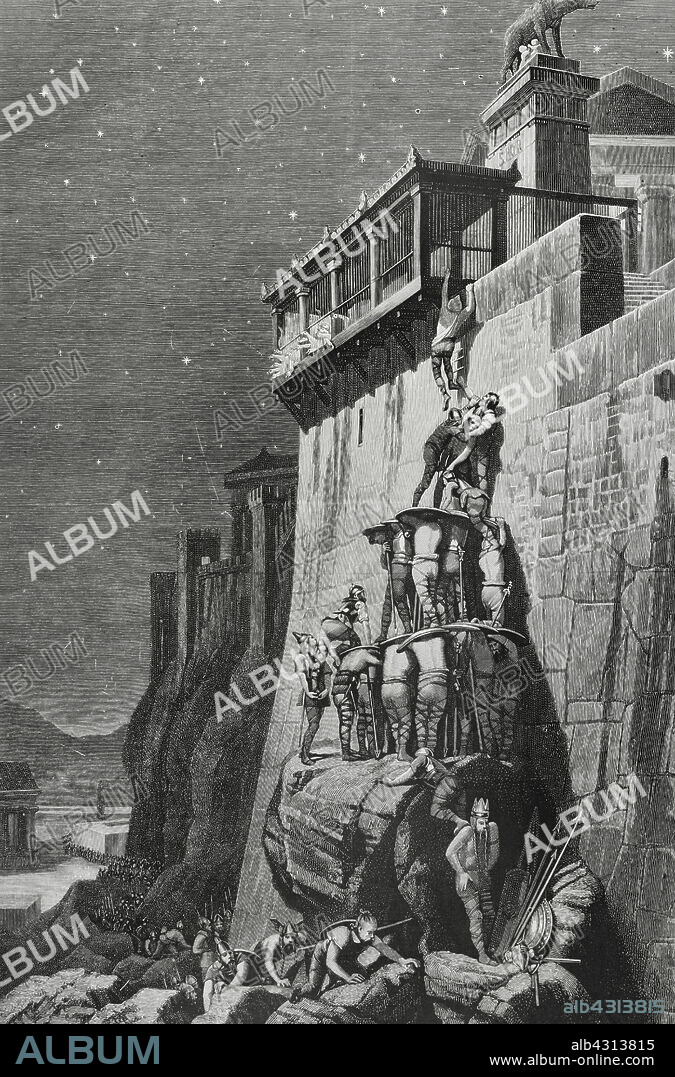alb4313815
C. ROBERTS. 19TH-CENTURY WOOD ENGRAVER.. Ancient Rome, 4th century BC. After the sack of Rome by the Gauls, the survivors of the city took refuge in the Capitol, raised on one of the city's hills and also where the temple of Juno was located. Inside the temple lived the sacred geese, used for sacrifices in honour of the goddess Juno. One night, the Gauls tried to attack the Romans who had taken refuge there. They climbed the hill, taking advantage of the silence of the night. The Roman guards and the dogs had fallen asleep, but the Gauls raiders encountered the geese, which became frightened and made a great fuss, waking the Romans. They were able to respond and repel the attack. However, the resistance to the Gauls' siege was prolonged and the Romans decided to pay a ransom to the Gauls in exchange for their leaving the city. Assault on the Roman Capitol by the Gauls. Engraving by C. Roberts based on a painting by Henri-Paul Motte (1846-1922). La Ilustración Española y Americana (The Spanish and American Illustration), February 29, 1884.

|
Zu einem anderen Lightbox hinzufügen |
|
Zu einem anderen Lightbox hinzufügen |



Haben Sie bereits ein Konto? Anmelden
Sie haben kein Konto? Registrieren
Dieses Bild kaufen

Untertitel:
Siehe automatische Übersetzung
Ancient Rome, 4th century BC. After the sack of Rome by the Gauls, the survivors of the city took refuge in the Capitol, raised on one of the city's hills and also where the temple of Juno was located. Inside the temple lived the sacred geese, used for sacrifices in honour of the goddess Juno. One night, the Gauls tried to attack the Romans who had taken refuge there. They climbed the hill, taking advantage of the silence of the night. The Roman guards and the dogs had fallen asleep, but the Gauls raiders encountered the geese, which became frightened and made a great fuss, waking the Romans. They were able to respond and repel the attack. However, the resistance to the Gauls' siege was prolonged and the Romans decided to pay a ransom to the Gauls in exchange for their leaving the city. Assault on the Roman Capitol by the Gauls. Engraving by C. Roberts based on a painting by Henri-Paul Motte (1846-1922). La Ilustración Española y Americana (The Spanish and American Illustration), February 29, 1884.
Standort:
Privatsammlung
Bildnachweis:
Album / Prisma
Freigaben (Releases):
Model: Nein - Eigentum: Nein
Rechtefragen?
Rechtefragen?
Bildgröße:
3425 x 5199 px | 50.9 MB
Druckgröße:
29.0 x 44.0 cm | 11.4 x 17.3 in (300 dpi)
Schlüsselwörter:
4. JAHRHUNDERT V. CHR. • 4. JAHRHUNDERT VOR CHRISTUS • 4. JH. V. U. Z. • AGILITÄT • ANGRIFF • ANTIKE • AUFRUHR • BARBAR • BARBAREN • BEFESTIGUNG: STADTMAUER • BELAGERUNG • BILDER • C. ROBERTS. 19TH-CENTURY WOOD ENGRAVER. • EINFALL • EINSCHLAFEN • ERKLIMMEN • EUROPA • EUROPAEER (F M) • EUROPAEER • EUROPÄER (F M) • EUROPÄER • EUROPÄISCH • FABEL • FLINKHEIT • GALLIER • GALLISCH • GANS (ZOOLOGIE) • GANS • GEMAELDE • GERAEUSCH • GERÄUSCH • GESCHICHTE • GRAVUR • HERRSCHAFT • HINAUFSTEIGEN • HUND • IN GEMAELDEN • INNENRAEUME: IN GEMAELDEN • KADER • KLETTERN • KLETTERND • KRAFT • KRAWALL • KRIEG: BELAGERUNG • KRIEGER • LAERM • LEGENDE • LEGENDE, SAGE • LÄRM • MACHT • MALEN • MALEREI • MAUER (ARCHITEKTUR) • MYTHOLOGIE • NACHT • PERIODE: ROEM. KAISERREICH • PRIVATSAMMLUNG • RECKE (HELD) • ROEMISCH • ROEMISCHES REICH • ROM • ROM, KAISERLICHES • RUHE (STILLE) • RÖMER • RÖMISCH • RÖMISCHES REICH • SACCO DI ROMA • SCHLAF (SCHLAFEN) • SCHLAF • SCHLAFEN (SCHLAF) • SCHLAFEN • SENONEN • STADTMAUER • STADTMAUER, BEFESTIGUNG • STAERKE • STICH (KUNST) • STILLE • STRATEGIE • STUMMHEIT • STURM (MILITAERISCH) • TAGESZEIT: NACHT • UEBERFALL • WAND • WENDIGKEIT • WESTROEMISCHES REICH • WESTRÖMISCHES REICH • ZEITGESCHICHTE
 Pinterest
Pinterest Twitter
Twitter Facebook
Facebook Link kopieren
Link kopieren Email
Email
